In this tutorial we’ll be using the Nexmo Voice API to make private calls, by forwarding a call via a voice proxy, and as an additional bonus we’re also going to add a recording feature to it at the end.
Find out more of what can be done with Node-RED at Vonage Campus, our first customer and developer conference taking place in San Francisco on October 29-30. It’s free to attend, so register to join us now!
If you’ve ever wondered how you can contact your ride share driver, Airbnb host or courier without knowing their number, or you’re simply interested in making private calls, follow along and find out how this is done!
Dependencies
Prerequisites
Before getting started, you’ll need a few things:
- Node.js and Node-RED installed, if you’re developing locally
- A Nexmo account — create one for free if you haven’t already
- A way to expose your server to the internet. This either means you’re running a hosted version of Node-RED, or using a tunneling service like ngrok – get up to speed with this Getting Started with Ngrok in Node-RED tutorial
Getting Your Credentials
To use the Nexmo nodes in Node-RED you’ll have to provide your credentials, so it’s best to keep them handy. Go to your dashboard to find your API key and secret and make a note of them.
Next, you’ll need a Voice-enabled virtual number. Go to Numbers > Buy numbers to get one.
Setting Up Your Node-RED Editor
Access your Node-RED editor by pointing your browser at http://localhost:1880.
Once you have the editor open, you’ll need to install the Nexmo nodes. You can do so under the Manage palette menu, by searching for the node-red-contrib-nexmo package and clicking install.
Now you should see all of the Nexmo nodes appear on the left side of your screen – in your node palette, among other default nodes.
Expose Your Local Server to the Internet
In case you’re not using a hosted version of Node-RED, the Nexmo Voice API will need another way to access your webhook endpoints, so let’s make your local server accessible over the public internet. If you’re running Node-RED on a public web server instead of your local machine, you’re all set and ready to move on to the Create a Nexmo Voice Application step.
A convenient way to do this is by using a tunneling service like ngrok, and there is a node for it that you can install directly from your editor.
Feel free to also check out our tutorial on Getting Started with Ngrok in Node-RED to find out more.
Once you’ve installed the ngrok node and restarted your editor, the ngrok node should appear in you node palette. It takes the strings on or off as input to start/stop the tunnel, and outputs the ngrok host address as the msg.payload.
Import from Clipboard the snippet below, or have a stab at building this path yourself.
[{ "id": "faed0f7.1e524f", "type": "inject", "z": "5b8bbfc3.1a9f18", "name": "", "topic": "", "payload": "on", "payloadType": "str", "repeat": "", "crontab": "", "once": false, "onceDelay": 0.1, "x": 190, "y": 100, "wires": [ [ "8a01baeb.6756d"] ] }, { "id": "11051fa9.75bd1", "type": "inject", "z": "5b8bbfc3.1a9f18", "name": "", "topic": "", "payload": "off", "payloadType": "str", "repeat": "", "crontab": "", "once": false, "onceDelay": 0.1, "x": 190, "y": 160, "wires": [[ "8a01baeb.6756d"] ] }, { "id": "8a01baeb.6756d", "type": "ngrok", "z": "5b8bbfc3.1a9f18", "port": "1880", "creds": "5a9e2b8c.173a2c", "region": "ap", "subdomain": "", "name": "", "x": 400, "y": 140, "wires": [[ "93fd5675.743c1"] ] }, { "id": "93fd5675.743c1", "type": "debug", "z": "5b8bbfc3.1a9f18", "name": "", "active": true, "tosidebar": true, "console": false, "tostatus": false, "complete": "false", "x": 620, "y": 140, "wires": [] }, { "id": "5a9e2b8c.173a2c", "type": "ngrokauth", "z": "" } ]
At this point, your editor should look similar to this:
As the last step before hitting Deploy , open up the ngrok node properties and specify the port number (1880 for Node-RED) and the Region.
You can also add your authtoken for your ngrok account if you have one. Don’t worry if you don’t, just skip this step for now. The node will warn that it is not fully configured but this is not an issue.
Hit Deploy and click on the on inject node’s button, then navigate to the URL displayed in the debug area (YOUR_URL for future reference) to find your Node-RED editor at a public address.
Create a Nexmo Voice Application
Some of Nexmo’s APIs, including the Voice API, use Nexmo Applications to hold security and config information needed to connect to Nexmo endpoints.
In the Nexmo Node-RED palette, several nodes have the capability to create these applications: getrecording , earmuff , mute , hangup , transfer , createcall , playaudio , playtts and playdtmf.
Drag any of these nodes into your workspace, then double-click on it to open up the node properties.
Next to the Nexmo Credentials, select “Add new nexmovoiceapp…” from the drop-down menu and click the edit button. Fill in the details below and click Create New Application.
| KEY | DESCRIPTION |
|---|---|
Name |
Choose a name for your Voice Application, for example “Nexmo Voice Application”. |
API Key |
Your Nexmo API key, shown in your account overview. |
API Secret |
Your Nexmo API secret, shown in your account overview. |
Answer URL |
YOUR_URL/answer, you’ll be hosting a Nexmo Call Control Object (NCCO) here. – more about this later on. |
Event URL |
YOUR_URL/event, you’ll need to reference this when setting up the event handler. |
Node-RED will then create a new Nexmo Application on your account and fill in the App ID and Private Key fields. After this step, feel free to delete the Nexmo node you used, as a nexmovoiceapp config node has been created, and that contains all the Nexmo credentials this flow needs.
Set Up a Number to Call
Next, you’ll have to link your virtual number to this application.
Find the Voice Application you’ve just created in your Nexmo Dashboard by navigating to Voice > Your Applications.
Click on the name of this application, then under the Numbers tab click on the Link button next to the virtual number you’ve rented earlier.
In case the number you’d like to use is already linked to another app, click on Manage number and configure it to forward incoming calls to your app.
Bonus tip: Use a comment node to take note of the Nexmo number linked to your application, this way you always have it handy.
Handle Inbound Calls
When you receive an inbound call, the Nexmo Voice API makes a GET request to an endpoint you define, YOUR_URL/answer, and expects a set of instructions on how to handle the call.
These instructions come in the form of a Nexmo Call Control Object, also known as NCCOs.
There are lots of different actions available, find the corresponding nodes under the Nexmo palette in your Node-RED editor or check out the NCCO Reference to find out more about them.
For this tutorial we’ll be using the connect action, so that when the inbound call is received, it gets connected to a new phone number we specify.
Define the Webhook Endpoint for Inbound Calls
Add a voice webhook and a return ncco node to your workspace, and wire them together to define a webhook endpoint.
Next, open up the voice webhook node properties, select GET as a Method and type /answer in the URL field, then press Deploy.
Great! Now you have a webhook that returns an NCCO to Nexmo’s API. At this point it doesn’t contain any actions, so let’s add one!
Build the Nexmo Call Control Object
To forward the incoming call, we need to connect it to a new endpoint. To do so, we need a connect action.
Add a connect node in between the voice webhook and a return ncco nodes. This will add a connect action to the NCCO.
Open up the connect node editor, select Phone as an Endpointand type in the number you’d lilke to call in the Number {} field.
Leave the From {} field empty for the Caller ID to appear as unknown, or fill it in with one of your Nexmo virtual numbers.
To find out more about the other parameters and the connect action, check out the NCCO Reference.
Log Call Events
Finally, connect an http in node to an http response node, as well as to a debug node, so that you can view your call events in the debug area.
In the http input node, select POST as a Method and fill in the URL field with /event.
The http response node should have 200 set as Status code, but don’t worry about it, this is the default value as well.
Now call your Nexmo number and follow your call events in the debug sidebar!
Add a Recording Feature
When making business phone calls, it’s often helpful to have the option to also record them. So let’s have a look at how we can transform the flow above to give us a recording of the conversation.
Update the NCCO
First, we’ll need a record action added to the Nexmo Call Control Object.
Recording starts when the record action is executed in the NCCO and finishes when the synchronous condition in the action is met. That is, End On Silence, timeOut or endOnKey.
If you do not set a synchronous condition, the Voice API immediately executes the next NCCO without recording.
In our use case, this means that we need to add a record node before the connect node, and no End On Silence, Time Out or End On Key values should be set.
Go ahead and add a record node to your flow, between the voice webhook and connect nodes.
Open up its properties, fill in the URL {} field with something like YOUR_URL/record, select POST as a Method and pick a Format for the recording file – I’ll go with MP3. You could also tick Beep Start to have a clear indication of when exactly the recording starts.
Add Handler for the Recording eventURL
Next, we need to add a handler for the recording eventURL – YOUR_URL/record.
This way we receive the event on completion of recording, and then be able to download said recording to our machine.
Add an http in node and an http response node to your workspace and wire them together. Consider also adding a debug node to see what’s coming through the recording eventURL.
In the http input node, select POST as a Method and fill in the URL field with /record.
The http response node should have 200 set as Status code, but this is the default value as well.
Download Recording
Once the recording has completed, Nexmo sends us the recording URL in the recording event webhook . The last step is fetching the recording and downloading it.
For this step we’ll need a getrecording node to fetch the recording audio from the supplied URL, and a file node to write it to a file on our machine.
Add a getrecording node after the /record http in node, then in its node properties select the voice application created earlier from the Nexmo Credentials drop-down and provide an absolute path as Filename {}.
And finally, add a file node after getrecording. In its node editor, make sure the Create directory if it doesn’t exist? option is ticked and select either overwrite or append to file from the Action drop-down. Leave the Filename field empty, as this value will be passed in from the getrecording node, in {{msg.filename}}.
That’s a wrap! Get a second device or have a friend call your Nexmo number, have a conversation and once you’re done, the recording file will be waiting for you, already domnloaded to your machine. Enjoy!



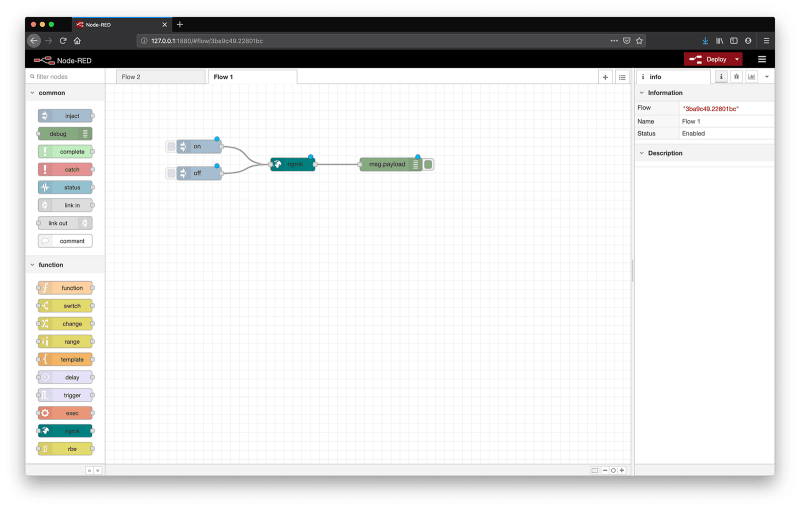

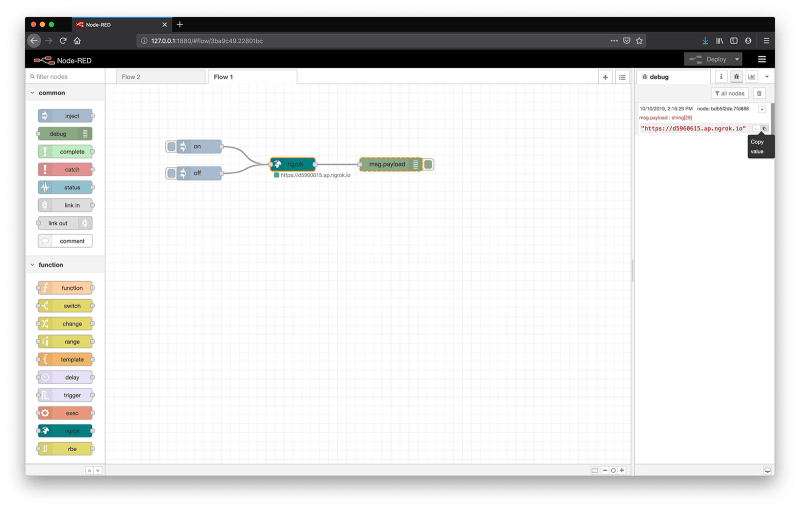
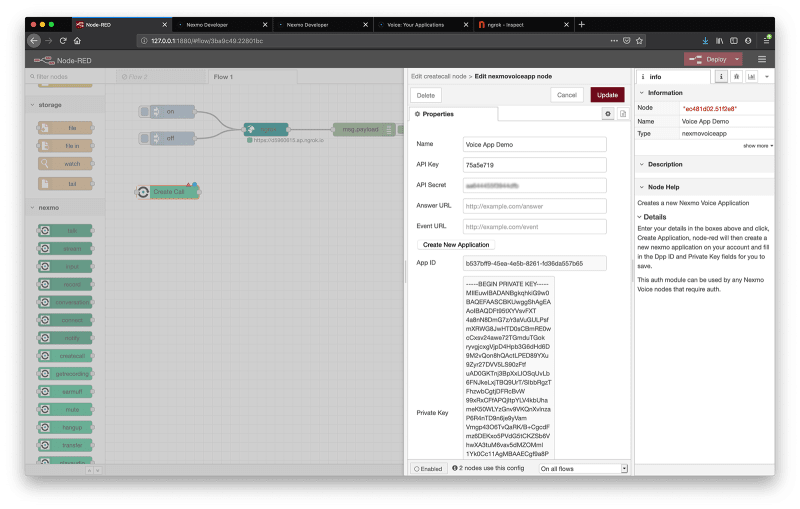

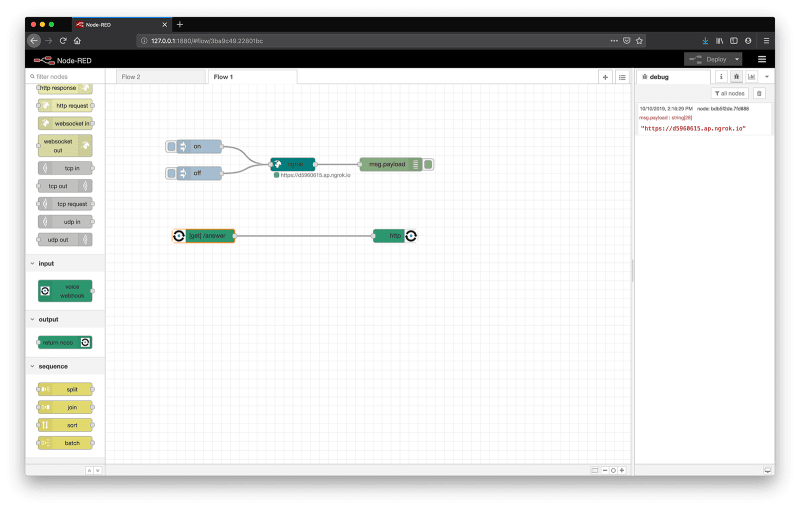


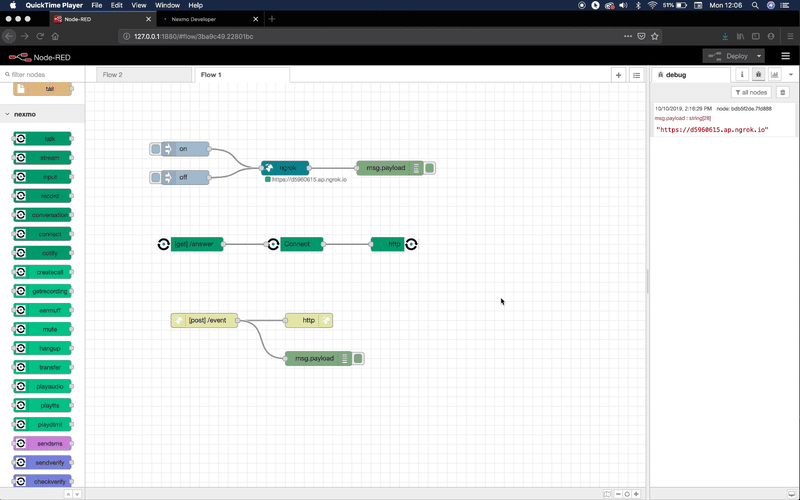
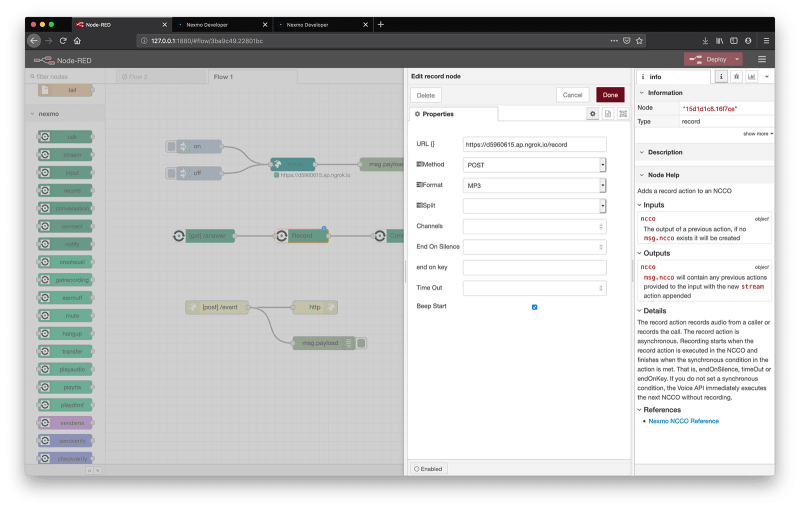

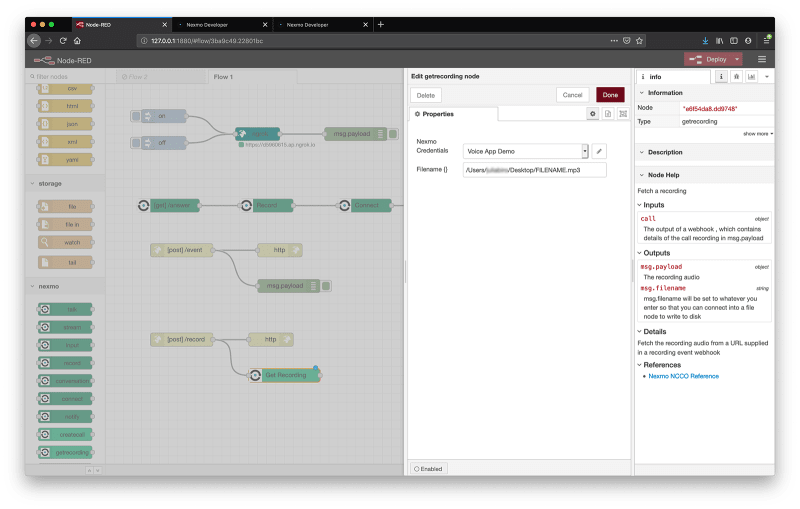
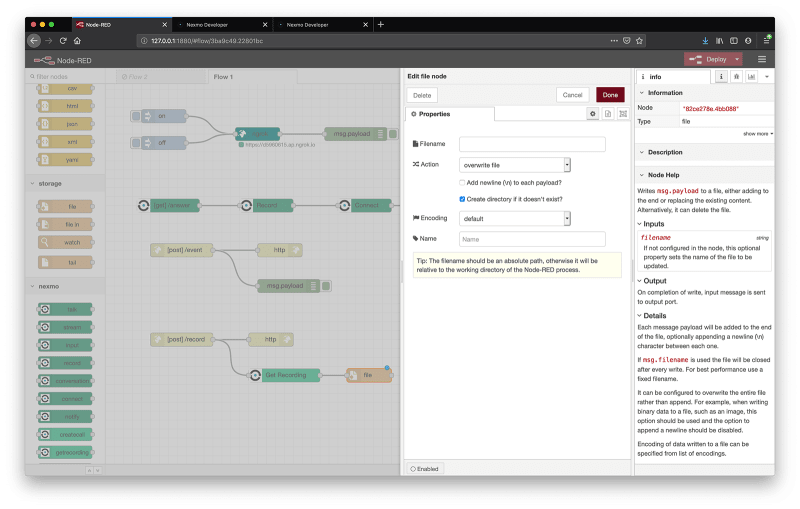
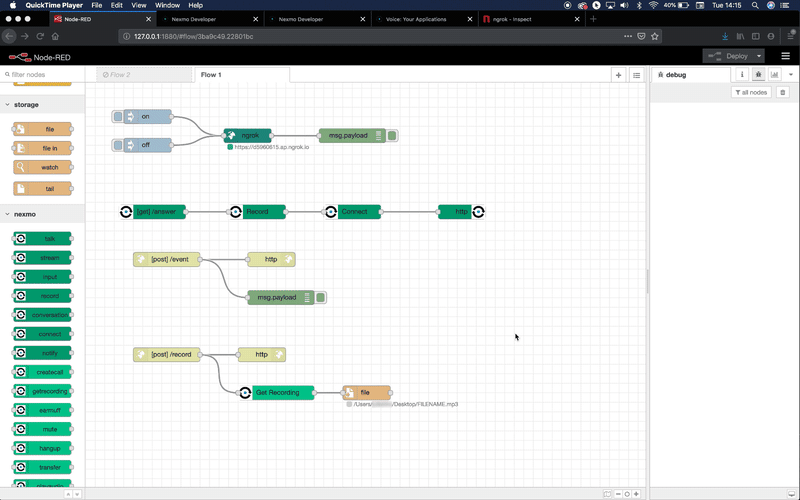




Top comments (0)